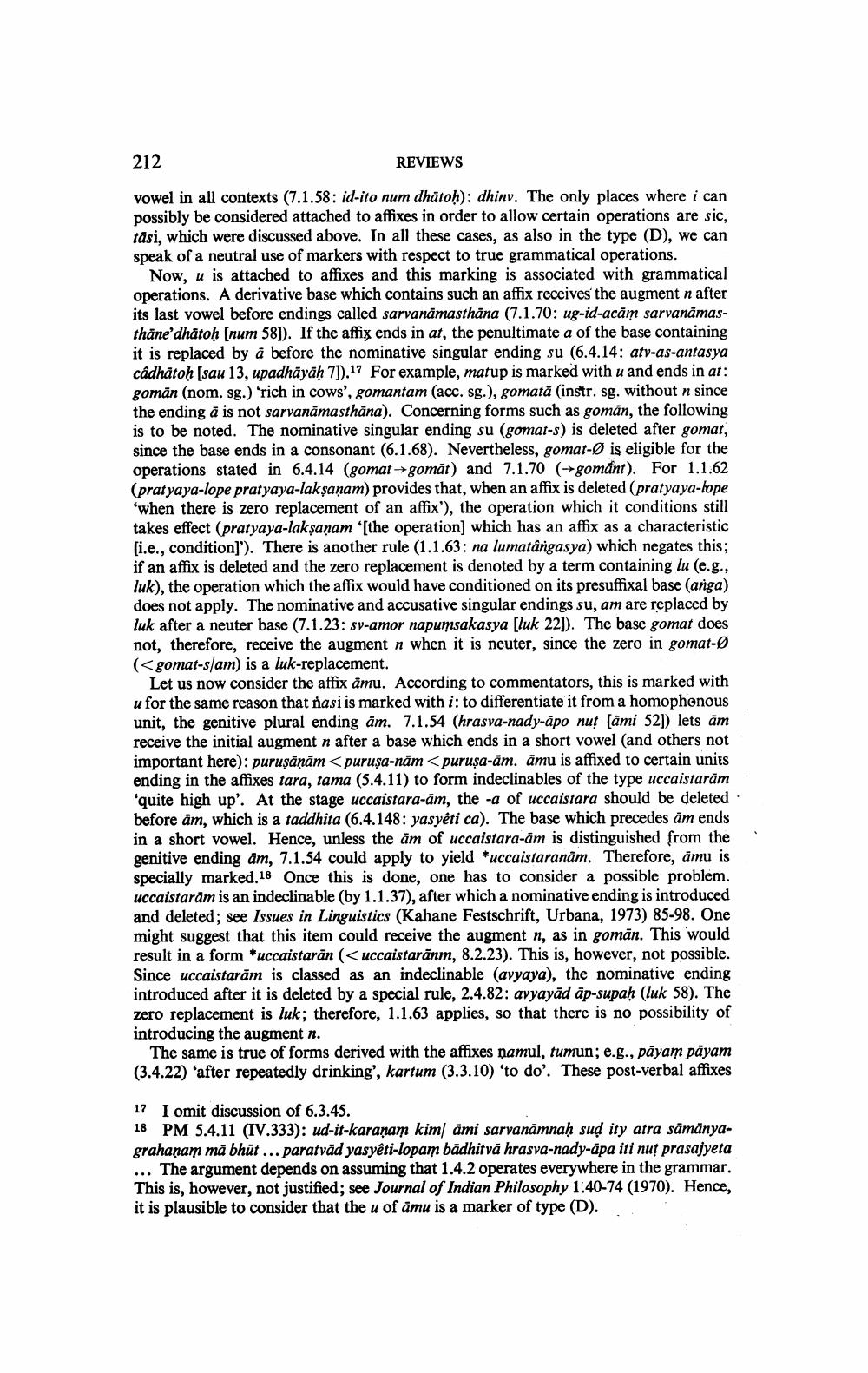________________ 212 REVIEWS vowel in all contexts (7.1.58: id-ito num dhatoh): dhiny. The only places where i can possibly be considered attached to affixes in order to allow certain operations are sic, tasi, which were discussed above. In all these cases, as also in the type (D), we can speak of a neutral use of markers with respect to true grammatical operations. Now, u is attached to affixes and this marking is associated with grammatical operations. A derivative base which contains such an affix receives' the augment n after its last vowel before endings called sarvanamasthana (7.1.70: ug-id-acam sarvanamasthane'dhatoh (num 58]). If the affix ends in at, the penultimate a of the base containing it is replaced by a before the nominative singular ending su (6.4.14: atv-as-antasya cadhatoh (sau 13, upadhayah 7]).17 For example, matup is marked with u and ends in at: goman (nom. sg.) 'rich in cows', gomantam (acc. sg.), gomata (instr. sg. without n since the ending a is not sarvanamasthana). Concerning forms such as goman, the following is to be noted. The nominative singular ending su (gomat-s) is deleted after gomat, since the base ends in a consonant (6.1.68). Nevertheless, gomat-O is eligible for the operations stated in 6.4.14 (gomat -gomat) and 7.1.70 (-gomant). For 1.1.62 (pratyaya-lope pratyaya-laksanam) provides that, when an affix is deleted (pratyaya-lope 'when there is zero replacement of an affix'), the operation which it conditions still takes effect (pratyaya-laksanam '[the operation) which has an affix as a characteristic [i.e., condition]'). There is another rule (1.1.63: na lumatangasya) which negates this; if an affix is deleted and the zero replacement is denoted by a term containing lu (e.g., luk), the operation which the affix would have conditioned on its presuffixal base (anga) does not apply. The nominative and accusative singular endings su, am are replaced by luk after a neuter base (7.1.23: sv-amor napumsakasya (luk 22]). The base gomat does not, therefore, receive the augment n when it is neuter, since the zero in gomat-O (<gomat-s/am) is a luk-replacement. Let us now consider the affix amu. According to commentators, this is marked with u for the same reason that nasi is marked with i: to differentiate it from a homophonous unit, the genitive plural ending am. 7.1.54 (hrasva-nady-apo nut [ami 52]) lets am receive the initial augment n after a base which ends in a short vowel (and others not important here): purusanam <purusa-nam <purusa-am, amu is affixed to certain units ending in the affixes tara, tama (5.4.11) to form indeclinables of the type ucсaistarām 'quite high up'. At the stage ucсaistara-ām, the -a of ucсaistara should be deleted before am, which is a taddhita (6.4.148: yasyeti ca). The base which precedes am ends in a short vowel. Hence, unless the am of ucсaistara-ām is distinguished from the genitive ending am, 7.1.54 could apply to yield *uccaistaranam. Therefore, amu is specially marked.18 Once this is done, one has to consider a possible problem. ucсaistaram is an indeclinable (by 1.1.37), after which a nominative ending is introduced and deleted; see Issues in Linguistics (Kahane Festschrift, Urbana, 1973) 85-98. One might suggest that this item could receive the augment n, as in goman. This would result in a form *uccaistaran (< ucсaistarānm, 8.2.23). This is, however, not possible. Since ucсaistarām is classed as an indeclinable (avyaya), the nominative ending introduced after it is deleted by a special rule, 2.4.82: avyayad ap-supah (luk 58). The zero replacement is luk; therefore, 1.1.63 applies, so that there is no possibility of introducing the augment n. The same is true of forms derived with the affixes namul, tumun; e.g., payam payam (3.4.22) 'after repeatedly drinking', kartum (3.3.10 'to do'. These post-verbal affixes 17 I omit discussion of 6.3.45. 18 PM 5.4.11 (IV.333): ud-it-karanam kim ami sarvanamnah sud ity atra samanyagrahanam ma bhut ... paratvad yasyeti-lopam badhitva hrasva-nady-apa iti nut prasajyeta ... The argument depends on assuming that 1.4.2 operates everywhere in the grammar. This is, however, not justified; see Journal of Indian Philosophy 1:40-74 (1970). Hence, it is plausible to consider that the u of amu is a marker of type (D).




